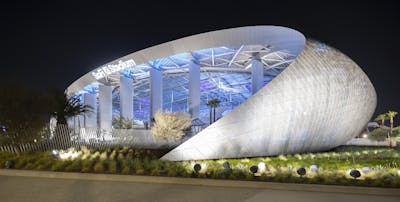
The complete article was published in the Summer 2023 edition of Gameday Security.
Overview
Implementing innovative design strategies and cutting-edge technologies plays a crucial role in enhancing the safety and security of venues. By deploying these advancements, venues can create environments that prioritize the well-being and protection of occupants, staff, and visitors alike. Such measures not only ensure a higher level of security but also contribute to fostering a sense of confidence and peace of mind among all stakeholders.
To provide some context regarding how stadium safety and security concerns have escalated over the past quarter-century, Brady Spencer—a senior principal at venue design firm Populous—offers this stark comparison: “Back then, I think we were more focused on security around the stadium. Things like bullet-resistant glazing for ticket windows and anti-graffiti and anti-vandalism materials outside. Now that focus has really moved to the outer perimeter of stadiums.”
Lines of jersey barriers and chain-link fencing won’t be enough these days, he adds, noting that anti-scale and anti-pass fencing are becoming more common specifications for both new venues and renovation projects. Those types of barriers often feature anti-cut welded heavy steel wire mesh that make it difficult to establish a foothold or slip through a weapon to an individual on the other side.
“Stadiums are places where people gather to experience sports or concerts, and we don’t want them to look like prisons,” Spencer says. “We want them to be inviting, but they also have to be secure. It’s all about balancing those two priorities with something that is visually appealing and integrates with the design of the stadium and its surrounding environment as a whole.”
Even the use of traditional perimeter security solutions such as bollards, wedge barriers, and drop arms should be reconsidered—not necessarily for practicality but for their overall effectiveness. Older barriers might not be rated, according to Matt Nebel, director of secure design for the international engineering consulting firm Walter P Moore. Today’s vendors sell products rated by various testing agencies to meet certain standards.
“When a 15,000-pound truck traveling at a certain speed rams into a barrier, how far does that truck propagate past the barrier?” he says. “When we do our assessments, we’re determining, based upon our engineering analysis, what rating for a barrier is needed at certain points of the facility. And then we work with proprietary vendors to procure and install those particular rated barriers around the site. If a barrier is not rated, it may not have the right strength to stop the vehicle.”
In fact, Nebel says he and his team of experts have started referring to “perimeter security design” as “vehicle impact design.” Many ramming vehicle incidents are not the work of bad actors but rather distracted or impaired drivers.
Safety- and security-related design improvements are happening inside stadiums, too. Concourses are wider and more open, and frequently used elements such as entry doors and restroom plumbing now feature stronger, thicker materials to better withstand fan abuse. Similarly, upgrading or re-anchoring signage that is easily accessible and tempting for fans to steal or damage can be accomplished with tamper-resistant screws or hidden fasteners. And replacing old-technology lighting with LED lighting not only will be more energy efficient but shine more brightly on concourse areas and other indoor and outdoor spaces—especially those that previously weren’t well-lit.
Electronic ticketing is now reaching new levels of sophistication, too, according to Spencer. Many stadiums now equip suite entrances, certain elevators, and other limited-access areas with ticket scanners to allow access only to authorized guests. That practice works for players, too, in the form of facial recognition readers that eliminate the need for members of a home team to carry badges to enter access-controlled spaces such as locker rooms.


